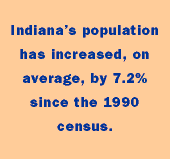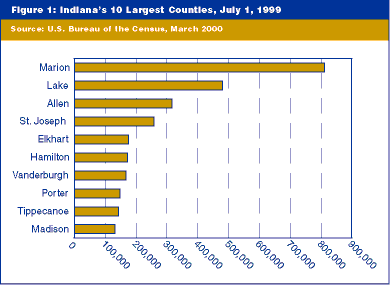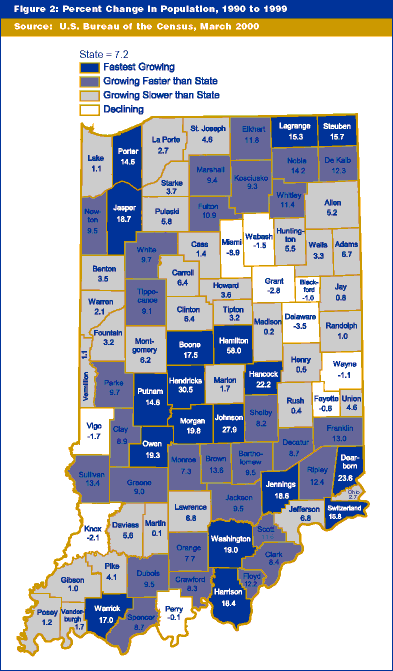Using Data in Context
There are multiple ways of looking at the economy of an area. Population data; employment data by industry, residence, or occupation; wage data; and gross production data are important elements of an economy. It is best to consider these data together when trying to predict or influence economic activity.
Employment data are the primary focus of IN Context, as they provide a forum for disseminating three major data sets collected by the Indiana Department of Workforce Development for several federal programs. These data sets include:
- Current Employment Survey (CES): CES is a monthly survey of all nonfarm businesses that provides data on employment by industry. Manufacturing wages and hours worked are also collected. These data are presented and analyzed each month in the section titled "IN the Workforce."
- Covered Employment and Wages (CEW): CEW is a quarterly census of all businesses in Indiana that fall under the Unemployment Insurance laws. The data include the number of firms, employment and wages by industry and county. The section titled "IN Business" looks at different aspects of these data each month, focusing generally on a region or industry.
- Local Area Unemployment Survey (LAUS): The LAUS program provides monthly and annual average estimates for Indiana's labor force, employment and unemployment. It also provides these estimates for the unemployment rate in approximately 150 areas of the state: statewide, metropolitan statistical areas (MSAs), counties and cities with a population 25,000 or more. The data in the LAUS series are the official data used for federal fund allocations and are based on a statistical methodology that uses data from a variety of sources. The statistical model is consistent across states, so areas can be compared. "IN Local Areas" covers aspects of these data each month.
The goal of this publication is to present these data sets "in context," showing employment over time and space and in relation to other economic data. Several articles in this and previous issues of IN Context consider the relationship between population and employment, while others focus on a specific geography or industry. Future issues will incorporate occupational data, gross state product data and exports.
Growth Indicated in Population Estimates for July 1, 1999
Most Indiana counties continue to experience population growth, according to population estimates released by the U.S. Bureau of the Census in March.

Changes and shifts in population are important variables impacting economic development. Economic development requires that businesses have access to land, capital and workers. To stimulate economic development, each element of this equation must be understood. Access to workers in a given area can be understood in part by knowing the population trends and patterns of that area. An increase or decrease in population may alter the availability of labor, and in turn, the unemployment and wage rates. Areas with rapidly expanding populations are generally appealing to prospective companies because they provide opportunities for growth. This article highlights important aspects of Indiana's population patterns that may be impacting the state's economy.
According to U.S. Bureau of Census population estimates for July 1, 1999, Indiana's population has increased, on average, by 7.2% since the 1990 census. Domestic migration is driving the state's population growth, with the fastest-growing Hoosier counties experiencing the largest amounts of positive net domestic migration (more people from other states and counties moving in than moving out). International migration to Indiana has also steadily increased since 1990. The vast majority of international in-migrants are moving to Hoosier counties with the largest populations: Marion, Lake and Allen.
The 10 largest Hoosier counties in terms of population are Marion, Lake, Allen, St. Joseph, Elkhart, Hamilton, Vanderburgh, Porter, Tippecanoe and Madison.

Hamilton County passed Vanderburgh County in the most recent year to become the sixth most populous county in the state. The smallest Indiana counties are Ohio, Union, Warren, Switzerland and Benton, each with a population under 10,000. The 1999 population estimates indicate that 47 Hoosier counties have grown faster than the state as a whole. Thirty-five of Indiana's counties have grown in population since 1990, but more slowly than the state. Ten Indiana counties experienced a population decline.

The fastest-growing Hoosier county continues to be Hamilton County, home of rapidly growing Fishers, Noblesville and Carmel. Hamilton County has added more than 63,000 people since the 1990 census, for a growth rate of 58% between 1990 and 1999. Hamilton County led the state in population growth rates for each year in the decade, with a growth rate of about 5% each year. In fact, Hamilton County has been the fastest-growing county in the region—Indiana, Illinois, Michigan, Ohio and Kentucky—and the 27th fastest-growing county in the nation since the 1990 census. Nationally, the fastest growing counties since 1990 are in Colorado and Georgia. (See "IN Business" for more details on population and employment growth in Hamilton County.)
Other Hoosier counties experiencing high rates of growth since 1990 include Hendricks (30.5%), Johnson (27.9%), Dearborn (23.6%) and Hancock (22.2%). The high population growth rates in these suburban Hoosier counties are consistent with growth patterns experienced by the nation as a whole. The counties experiencing growth of 2% or more in the last year were Hendricks, Johnson, Morgan, Boone, Harrison and Hancock.
Marion County's population has seen an overall increase of 13,800 people since 1990, but has experienced a decline of 4,800 people since 1996. Earlier in the decade, Marion County's natural increase (more births than deaths) exceeded its out-migration, resulting in population growth. Since 1996, however, the county's out-migration has exceeded its natural increase, resulting in population loss. The county has experienced growing domestic out-migration during the decade (increasing numbers of people moving to other states), but migration from other countries to Marion County has increased steadily throughout the decade.
Miami County has lost population since the 1990 census due to the restructuring of Grissom Air Force Base in the early '90s. The county's population is down by 8.9% since the census, but it has seen population increases in each of the most recent four years, with population growth of more than 1,200 people since 1995. Other counties experiencing population decline since 1990 were Delaware County, down by 4,200 people or 3.5%; Grant County, down by 2,100 people or 2.8%; Vigo County, down by 1,800 people or 1.7%; and Knox County, down by 800 people or 2.1%. Counties showing smaller rates of decline include Wabash, Wayne and Blackford.
Background on the Data
It is important to note that these population figures are estimates produced using a demographic model and are not the result of an attempt to directly count people, as will be done in April of this year. The U.S. Bureau of the Census, using a demographic technique called the Tax Return Method, produced this set of estimates. Estimates are produced annually, and when estimates for the next year are released, estimates for previous years are corrected or revised to reflect more up-to-date information that may be available.
